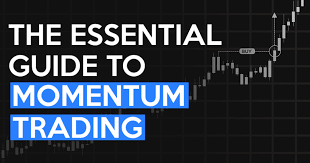Momentum traders and investors seek to profit on upward or negative price patterns in a stock or ETF. We've all heard the expression "the trend is your friend." And who doesn't like surfing a wave? Momentum traders assume that these trends will continue in the same direction because to the momentum that is currently in place.
Take a look at the highs.
If you're looking at price momentum, you'll be looking at stocks and ETFs that have been steadily rising day after day, week after week, and maybe many months in a row. Some individuals despise entering markets that are setting new highs. But it's crucial to note that there's a lot of evidence that markets that make new highs tend to make even greater highs.
Keep an eye out for volatility.
The volatility of momentum trading is larger than that of most other tactics. Momentum trading seeks to profit from market volatility. If buys and sells are not properly timed, they might result in large losses. To limit losses in a lost trade, most momentum traders use a stop loss or another risk management approach.
Methods for detecting price trends
Looking at the proportion of stocks and ETFs trading within 10% of their 52-week highs is one way to locate the best stocks and ETFs. You might also look at the % price change over the previous 12 or 24 weeks. The former strategy is often more responsive to recent price fluctuations.
Consider the oil and energy industry in mid-2008. It was consistently classified as one of the best sectors using those parameters based on its 12-week or 24-week price performance—even while it was falling. Because the gains were so high in the earlier half of the 12- or 24-week periods, even a significant reversal over a period of many weeks was lost amid the greater run-up that preceded it.
To detect patterns early on, consider using a shorter-term price change component, such as a 1-week or 4-week price change measure. This works for both entering and exiting a specific stock or ETF.
To discover the top sectors, follow these procedures.
To be a great momentum trader, you must be able to swiftly and precisely pick the best sectors. You can probably accomplish this manually with many of the available screeners, but the essential steps are as follows:
You must first identify the stocks and ETFs in which you are interested.
Determine the amount of equities and ETFs that are trading around their all-time highs.
Sort the selected stocks and ETFs from best to worst to discover which are doing the best.
Plan your entrance plan. You may wish to enter an instrument while it is displaying short-term strength, or you may want to wait for a pullback and purchase on weakness. Either technique may work; the crucial thing is to follow through on a strategy.
Create an exit plan. Going into the trade, you should determine at what moment (or circumstances) you will take gains and at what point (or conditions) you will leave with a loss.
Consider the dangers associated with momentum trading.
It's critical to remember that momentum trading is fraught with danger. In essence, you're making an investment choice in a company or ETF based on previous purchases by other market players. There is no certainty that purchasing forces will continue to drive up the price. A news event, for example, may influence investor market perception and result in widespread selling. Or, if many investors already have a long position in the ETF or stock, profit-taking on existing holdings may outnumber new purchasers entering the market, causing prices to fall.
